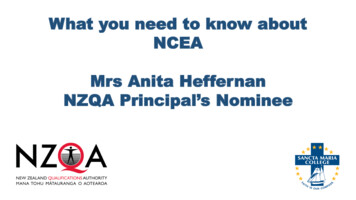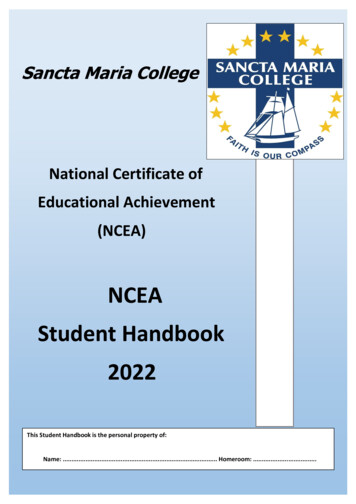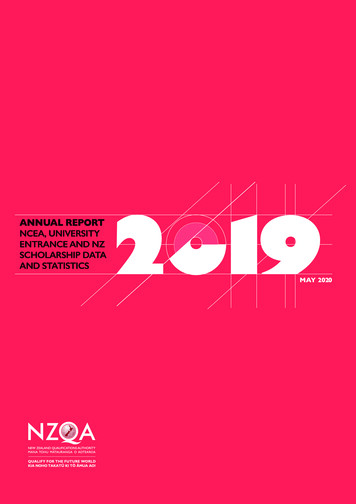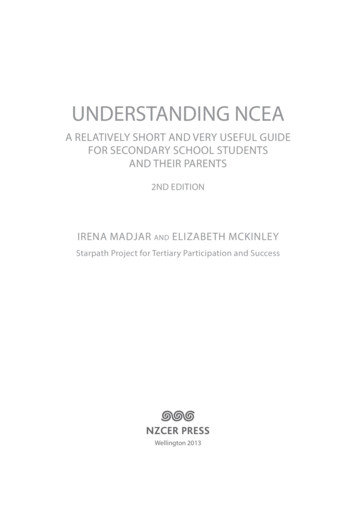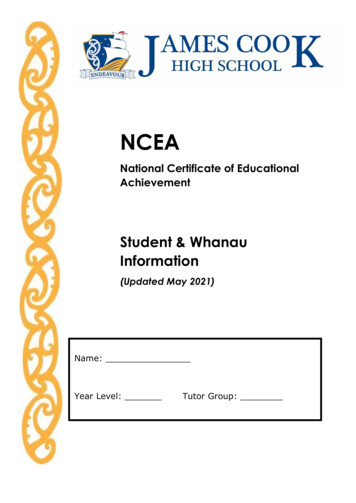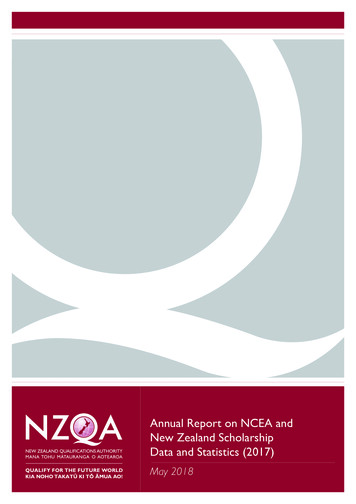
Transcription
Annual Report on NCEA andNew Zealand ScholarshipData and Statistics (2017)May 2018
ContentsIntroduction3Purpose of this Report4Attainment statistics are reported for four types ofstudent cohorts4Achievement in NCEA and University Entrance6Introduction6Roll-based Cohort Statistics6Statistics by Gender8Statistics by Ethnicity11Statistics by School Decile Band14Participating Cohort Statistics1750Course Endorsement51Percentage of Students with Endorsable CoursesGaining EndorsementStatistics by Gender52Statistics by Ethnicity53Statistics by School Decile Band54Percentage of Merit and Excellence Endorsements55Statistics by Gender56Statistics by Ethnicity57Statistics by School Decile Band5860New Zealand ScholarshipStatistics by Gender18Scholarship Monetary Awards60Statistics by Ethnicity21Scholarship Statistics for 201761Statistics by School Decile Band24Scholarships Awarded in 2017 by Subject6227Premier Awards and Outstanding Scholar Awards65Statistics by Gender2967Statistics by Ethnicity31Scholarship Awards, Single Subject Awards andTop Subject Awards in 2017Literacy and Numeracy34Results of Directory of Assessment Standards(DAS)68Tracked Year 11 Cohort StatisticsLiteracy requirements34Numeracy requirements34School Related Qualifications84Alignment of Standards34NCEA Administrative processes and data86Literacy for NCEA Level 135The Role of NZQA in the Examination Process86Statistics by Gender36External Assessment86Statistics by Ethnicity37Reviews and Reconsiderations86Statistics by School Decile Band38External Moderation of Internal Assessment8839Breaches of Examination Rules89Statistics by Gender40Special Assessment Conditions (SAC)92Statistics by Ethnicity41Statistics by School Decile Band42Numeracy for NCEA Level 1Literacy and Numeracy for UE43NCEA Certificate Endorsement44Statistics by Gender46Statistics by Ethnicity47Statistics by School Decile Band4894AppendicesAppendix 1. Cohorts94Appendix 2. School Related Qualifications95Appendix 3. Glossary971
NCEA was set up as a flexible, standards-based, high-stakes assessment model that wasinclusive of all students, including those who had previously been excluded from gainingqualifications and for whom the schooling process was typically an alienating, negativeexperience. In this regard NCEA has been an undoubted success.Source:Hipkins, R., Johnston, M., Sheehan, M., (2016), NCEA in Context, NZCER Press, page 198.2
IntroductionThe Annual Report on NCEA and New ZealandScholarship Data and Statistics (2017) summarises theresults of New Zealand’s senior secondary students achievingthe National Certificate of Educational Achievement (NCEA)and New Zealand Scholarship in 2017.The New Zealand Scholarship Examinations enablecandidates to be assessed against challenging standardsand are demanding for the most able candidates ineach subject.Graphs of the statistics include information from previousyears to show trends, generally covering the five years2013-2017.Kristine KilkellyDeputy Chief ExecutiveAssessment DivisionNew Zealand Qualifications AuthorityThe statistics in this Annual Report were producedfrom data that was finalised on 28 March 2018 with theexception of Scholarship (2 May 2018).We will be moving to an updated single measureof NCEA attainment for future reporting from 2019.The new measure has been developed jointly byNZQA and the Ministry of Education.In summary, the Annual Report shows pleasing results.The New Zealand Qualifications Authority is pleasedto present the statistics contained in this report.Karen PoutasiChief ExecutiveNew Zealand Qualifications Authority3
Purpose of this ReportThis report provides information about secondary-school qualifications administered by New Zealand QualificationsAuthority (NZQA). Its primary focus is the main New Zealand secondary school suite of qualifications, the NationalCertificate of Educational Achievement (NCEA) at Levels 1, 2, and 3. It also reports on the achievement of Literacyand Numeracy, Certificate Endorsement, Course Endorsement, University Entrance (UE), and New Zealand Scholarship.Some students pursue non-NCEA qualifications (e.g. Cambridge, or International Baccalaureate). These non-NCEAqualifications are not included in this report.The report also provides information and statistics related to the processes used to administer NCEA. These include: Processing requests for a review or a reconsideration of examination results Conducting external moderation of internal assessments Investigating breaches of examination rules, and Entitlements for Special Assessment Conditions.Attainment statistics are reported for four types of student cohortsAttainment statistics are used for varying purposes, includingthe monitoring of standards, student achievement, andquality of assessments. This diversity of purposes requiresdifferent types of statistics. There are four types ofpercentage statistics presented in this report. Each typeis distinguished by the underlying denominator that is usedto compute the percentages. The denominators used arebased on cohorts.The four types of cohorts are: Roll-based cohort Participating cohort Tracked Year 11 cohort Enrolled Student cohortEach cohort is explained in this section. Furtherinformation about cohorts is found in Appendix 1.4Roll-based cohortSecondary schools are required to report their schoolrolls four times a year to the Ministry of Education.For the purposes of this report the school roll as at1 July is used for forming the Roll-based cohort.The secondary school roll is separated into two groups:one group consists of students in Years 9-10, and thesecond group consists of students in Years 11-13.The Roll-based cohort is formed from the second groupof students. That is, the Roll-based cohort is students inYears 11-13 on the school roll as at 1 July, summed overall the secondary schools.
Purpose of this ReportParticipating cohortsEnrolled Student cohortParticipating cohorts refer to four categories:The Enrolled Student cohort consists of students inYears 11-13 with one or more entries in either a UnitStandard or an Achievement Standard. That is, studentsin the Enrolled Student cohort are those who have hadan enrolment created within the NZQA database. NCEA Level 1 certificate candidates in Year 11 cohort,i.e. ‘participating’ in NCEA Level 1 NCEA Level 2 certificate candidates in Year 12 cohort,i.e. ‘participating’ in NCEA Level 2 NCEA Level 3 certificate candidates in Year 13 cohort,i.e. ‘participating’ in NCEA Level 3 UE candidates in Year 13 cohort, i.e. ‘participating’ in UE.The NCEA Level 1 certificate candidates in Year 11 cohortconsists of Year 11 students who could accumulate bythe end of Year 11 the number of credits required for theNCEA Level 1 certificate.Definitions for the other three categories of Participatingcohorts follow in a similar manner.The Participating cohorts focus on students whosebehaviours signal that they are candidates for the NCEAqualifications, or UE. Therefore Participating cohorts areformed from the Enrolled Student cohort.1Each year there are students at secondary school whoundertake courses which are not assessed using standardsadministered by NZQA. Such students are in the Rollbased cohort but not the Enrolled Student cohort.SummaryThe Roll-based cohort consists of all Year 11-13 studentson secondary school rolls as at 1 July. The Participatingcohort consists of students from the Enrolled Studentcohort who seek NCEA qualifications. The Tracked Year11 cohort consists of Year 11 students from the EnrolledStudent cohort, and tracks their NCEA Level achievementsfrom Year 11 through to Year 13. The Enrolled Studentcohort consists of students with one or more entries ineither a Unit Standard or an Achievement Standard.Tracked Year 11 cohortThe Tracked Year 11 cohort is formed from the EnrolledStudent cohort. More formally, it is Year 11 students fromthe Enrolled Student cohort of an earlier year. Studentsin a Tracked Year 11 cohort are monitored from thebeginning of that earlier year through their senior years ofschooling for attainment of NCEA qualifications. For this2017 report the Tracked Year 11 cohort is made up ofthe Year 11 students from the Enrolled Student cohort of2015. The Tracked Year 11 cohort’s attainment rates ofNCEA qualifications are reported as at the end of 2017.1Students engaged in smaller programmes of assessment are unable to accumulate the number of credits by the end of year for a NCEA qualification and are excluded fromthe Participating cohort.5
Achievement in NCEA and University EntranceIntroductionThis section reports NCEA qualification and UE attainmentstatistics. It utilises three types of attainment statistics:As a result, students in Year 10 who achieve NCEA Level1 are excluded.2 Roll-based cohort statisticsFor the UE award it is the number of students awardedUE in Year 13. Participating cohort statistics Tracked Year 11 cohort statistics.The Roll-based cohort statistics show attainment as apercentage of the number of students reported to theMinistry of Education in the July school roll. The Participatingcohort shows attainment as a percentage of those who arecandidates for NCEA qualifications and UE. The TrackedYear 11 cohort statistics quantify attainment over the threeyears of senior secondary schooling.Roll-based Cohort StatisticsThe statistics are presented as a percentage of the numberof students who attain NCEA qualifications out of thetotal number of students on school rolls.A brief description of the data used in producing thestatistics in this section follows.Total number of students from the Roll-based cohortThe total number of students in the Roll-based cohortrefers to students in Years 11-13. The number is found bysumming the count of students in Years 11-13 from schoolrolls as at 1 July in a particular year.Statistics related to UENew UE requirements came into effect from 1 March 2014.The impact of the change was a reduction in the 2014 UEattainment rates from those in 2013. The reduction was anexpected outcome from the change in UE requirements.The UE attainment rates in 2017 show an increase fromtheir 2014 values. As seen in the following sections, the UEattainment rates for 2017 have increased for the most partfrom 2014.Number of students who achieve NCEA qualificationsor UEThe number of students who attain NCEA qualificationsis defined as the number of students who attain NCEALevels 1, 2, or 3, in Year 11, Year 12, and Year 13respectively. That is, the number of students who attain: NCEA Level 1 in Year 11 NCEA Level 2 in Year 12 NCEA Level 3 in Year 13.2In this example, excluding students in these other years results in an undercount of the number of students who achieve the NCEA Level 1 qualification. That is, it does notinclude the students who achieve the Level 1 qualification in Years 9, 10, 12, or 13.6
Achievement in NCEA and University EntranceFigures 1-13 show Roll-based attainment rates, between genders, ethnicities, and school decile bands for the three levelsof NCEA qualification and UE.Roll-based Year 11 Students Attaining NCEA Level 1, Year 12 StudentsAttaining NCEA Level 2, Year 13 Students Attaining NCEA Level 3 andUniversity Entrance100%90%Percentage of 7Year 11-NCEA Level 170.2%72.0%74.4%75.5%74.6%Year 12-NCEA Level 271.0%74.9%76.4%78.4%78.5%Year 13-NCEA Level 356.9%59.5%62.7%64.5%65.7%Year 13-UE51.0%45.5%48.6%49.2%49.4%Figure 1. Roll-based attainment rates of Year 11-13 students attaining NCEA Levels 1-3 and UE.7
Achievement in NCEA and University EntranceStatistics by GenderFigures 2-5 show Roll-based attainment rates of male and female students.Male and female attainment rates for UE shown in Figure 5 declined in 2014 from 2013 due to a policy changein UE requirements. Both male and female attainment rates for 2017 have increased from their 2014 percentages.8
Achievement in NCEA and University EntranceRoll-based Year 11 Students Attaining NCEA Level 1 by Gender100%90%Percentage of 9.0%79.3%79.2%Figure 2. Roll-based attainment rates of NCEA Level 1 by gender.Roll-based Year 12 Students Attaining NCEA Level 2 by Gender100%90%Percentage of 0.0%81.7%81.2%Figure 3. Roll-based attainment rates of NCEA Level 2 by gender.9
Achievement in NCEA and University EntranceRoll-based Year 13 Students Attaining NCEA Level 3 by Gender100%90%Percentage of 8.5%69.3%70.3%Figure 4. Roll-based attainment rates of NCEA Level 3 by gender.Roll-based Year 13 Students Attaining University Entrance by Gender100%90%Percentage of 5.0%55.3%55.4%Figure 5. Roll-based attainment rates of UE by gender.10
Achievement in NCEA and University EntranceStatistics by EthnicityFigures 6-9 show Roll-based attainment rates among New Zealand European, New Zealand Maˉori, Pasifika andAsian students.Ethnicity attainment rates for UE shown in Figure 9 declined in 2014 from 2013 due to a policy change in UErequirements. The ethnicity attainment rates for 2017 have increased from their 2014 percentages.11
Achievement in NCEA and University EntranceRoll-based Year 11 Students Attaining NCEA Level 1 by Ethnicity100%90%Percentage of 2017NZ European78.7%80.3%81.7%82.5%81.8%NZ M %73.2%73.3%Asian82.0%84.2%87.9%92.8%93.2%Figure 6. Roll-based attainment rates of NCEA Level 1 by ethnicity.Roll-based Year 12 Students Attaining NCEA Level 2 by Ethnicity100%90%Percentage of 2017NZ European78.6%82.2%83.0%84.0%84.5%NZ M %79.5%80.7%Asian85.1%87.2%89.7%93.9%97.8%Figure 7. Roll-based attainment rates of NCEA Level 2 by ethnicity.12
Achievement in NCEA and University EntranceRoll-based Year 13 Students Attaining NCEA Level 3 by Ethnicity100%90%Percentage of 2017NZ European63.7%66.4%69.0%70.1%70.4%NZ M %60.4%65.3%Asian69.6%71.1%75.4%79.2%82.3%Figure 8. Roll-based attainment rates of NCEA Level 3 by ethnicity.Roll-based Year 13 Students Attaining University Entrance by Ethnicity100%90%Percentage of 2017NZ European59.1%54.0%57.4%57.8%57.3%NZ M %30.7%32.3%Asian66.2%59.5%64.5%66.5%69.6%Figure 9. Roll-based attainment rates of UE by ethnicity.13
Achievement in NCEA and University EntranceStatistics by School Decile BandFigures 10-13 show Roll-based attainment rates between School Decile Bands 1-3, 4-7, and 8-10.There are a few schools with no specified decile, and their data have been omitted from these rate statistics.It is important to note that a school’s decile rating gives an indication of the average socio-economic level of studentsat the school, but it does not necessarily reflect the circumstances of particular students.School decile band attainment rates for UE shown in Figure 13 declined in 2014 from 2013 due to a policy changein UE requirements. The school decile band attainment rates for 2017 have increased from their 2014 percentages.14
Achievement in NCEA and University EntranceRoll-based Year 11 Students Attaining NCEA Level 1by School Decile Band100%90%Percentage of 2017Decile 1-358.4%60.7%64.5%66.4%66.4%Decile 4-771.7%74.2%76.5%78.0%77.4%Decile 8-1078.0%78.6%81.5%80.9%79.6%Figure 10. Roll-based attainment rates of NCEA Level 1 by school decile band.Roll-based Year 12 Students Attaining NCEA Level 2by School Decile Band100%90%Percentage of 2017Decile 1-361.1%66.8%70.1%73.2%73.7%Decile 4-773.4%77.2%78.8%80.8%80.9%Decile 8-1076.6%78.5%80.3%82.1%81.9%Figure 11. Roll-based attainment rates of NCEA Level 2 by school decile band.15
Achievement in NCEA and University EntranceRoll-based Year 13 Students Attaining NCEA Level 3by School Decile Band100%90%Percentage of 2017Decile 1-344.1%46.2%51.4%55.3%57.0%Decile 4-755.0%57.0%61.9%63.1%64.5%Decile 8-1069.0%70.8%74.4%75.4%76.4%Figure 12. Roll-based attainment rates of NCEA Level 3 by school decile band.Roll-based Year 13 Students Attaining University Entranceby School Decile Band100%90%Percentage of 2017Decile 1-333.0%25.2%28.2%30.0%29.0%Decile 4-748.1%41.1%46.6%46.3%46.4%Decile 8-1065.6%60.5%64.4%65.3%65.7%Figure 13. Roll-based attainment rates of UE by school decile band.16
Achievement in NCEA and University EntranceParticipating Cohort StatisticsSenior students generally strive for attainment ofeach level of NCEA qualification, and to meet the UErequirement. Years 11, 12, and 13 students typically aimfor NCEA Level 1, 2, and 3 respectively, and in Year 13also aim for UE. Some students, however, do not followthis typical pattern. For example, a Year 12 student mayaim for NCEA Level 3, or a Year 13 student may aim forNCEA Level 2.A student is in the Participating cohort if, on the basisof any credits already attained and credits currentlyentered for, it would be possible to attain NCEA Level1 in Year 11, Level 2 in Year 12, Level 3 in Year 13, bythe end of the year. The reported statistics in this sectionare the percentage of the Participating cohort for eachqualification, attaining the qualification by the end of thetypical year of doing so.Figures 14-26 compare Participating cohort attainmentrates over time, between genders, ethnicities and schooldecile bands for the NCEA qualification and UE.Participating NCEA Level 1 Certificate Candidates in Year 11, NCEALevel 2 Certificate Candidates in Year 12, NCEA Level 3 and UniversityEntrance Certificate in Year 13 Attaining CertificatePercentage of Participating 4201520162017Y11 - NCEA L182.6%84.2%85.7%86.5%86.1%Y12 - NCEA L285.8%88.3%88.7%90.0%90.1%Y13 - NCEA L379.6%80.7%83.2%83.7%84.5%Y13 - UE70.9%61.8%63.8%63.3%63.0%Figure 14. Participation-based attainment rates of Year 11-13 students attaining NCEA Levels 1-3 and UE.17
Achievement in NCEA and University EntranceStatistics by GenderFigures 15-18 compare the male and female attainment rates of the appropriate Participating cohorts from 2013 to 2017.Male and female attainment rates for UE shown in Figure 18 declined in 2014 from 2013 due to a policy change in UErequirements. Both male and female attainment rates for 2017 have increased from their 2014 percentages.18
Achievement in NCEA and University EntranceParticipating NCEA Level 1 Certificate Candidates in Year 11 AttainingCertificate by Gender100%90%Percentage of %88.6%89.0%88.9%Figure 15. Participation-based attainment rates of NCEA Level 1 by gender.Participating NCEA Level 2 Certificate Candidates in Year 12 AttainingCertificate by Gender100%90%Percentage of %91.3%92.3%92.0%Figure 16. Participation-based attainment rates of NCEA Level 2 by gender.19
Achievement in NCEA and University EntranceParticipating NCEA Level 3 Certificate Candidates in Year 13 AttainingCertificate by Gender100%90%Percentage of %87.0%87.0%87.7%Figure 17. Participation-based attainment rates of NCEA Level 3 by gender.Participating University Entrance Candidates in Year 13Attaining UE by Gender100%90%Percentage of %69.1%68.7%68.6%Figure 18. Participation-based attainment rates of UE by gender.20
Achievement in NCEA and University EntranceStatistics by EthnicityFigures 19-22 show Participating cohort attainment rates between New Zealand European, New Zealand Maˉori,Pasifika and Asian students.Attainment rates for UE shown in Figure 22 declined in 2014 from 2013 due to a policy change in UE requirements.The attainment rates in 2017 for New Zealand European, New Zealand Maˉori and Asian students have increasedfrom their 2014 percentages.21
Achievement in NCEA and University EntranceParticipating NCEA Level 1 Certificate Candidates in Year 11 AttainingCertificate by Ethnicity100%90%Percentage of 162017NZ European88.3%89.9%90.4%91.2%90.6%NZ M %77.1%77.4%Asian85.4%86.3%88.1%88.5%87.7%Figure 19. Participation-based attainment rates of NCEA Level 1 by ethnicity.Participating NCEA Level 2 Certificate Candidates in Year 12 AttainingCertificate by Ethnicity100%90%Percentage of Candidates80%70%60%50%40%30%20%10%0%NZ .1%NZ M %83.8%83.5%Asian85.8%86.9%87.1%89.5%89.8%Figure 20. Participation-based attainment rates of NCEA Level 2 by ethnicity.22
Achievement in NCEA and University EntranceParticipating NCEA Level 3 Certificate Candidates in Year 13 AttainingCertificate by Ethnicity100%90%Percentage of 162017NZ European83.7%84.8%87.1%87.5%87.7%NZ M %71.7%75.3%Asian82.6%84.9%85.7%86.2%87.8%Figure 21. Participation-based attainment rates of NCEA Level 3 by ethnicity.Participating University Entrance Candidates in Year 13 AttainingUniversity Entrance by Ethnicity100%90%Percentage of 162017NZ European77.3%69.2%71.8%71.7%71.0%NZ M %36.3%36.9%Asian78.1%71.8%72.8%72.3%73.8%Figure 22. Participation-based attainment rates of UE by ethnicity.23
Achievement in NCEA and University EntranceStatistics by School Decile BandFigures 23-26 compare the attainment rates of the appropriate Participating cohorts by school decile bands from2013 to 2017.Attainment rates for UE shown in Figure 26 declined in 2014 from 2013 due to a policy change in UE requirements.The school decile band attainment rates for 2017 have increased from their 2014 percentages.24
Achievement in NCEA and University EntranceParticipating NCEA Level 1 Certificate Candidates in Year 11 AttainingCertificate by School Decile Band100%90%Percentage of 162017Decile 1-371.6%73.8%76.3%78.0%78.5%Decile 4-780.8%83.0%84.6%85.7%85.8%Decile 8-1089.3%90.2%92.1%92.2%90.5%Figure 23. Participation-based attainment rates of NCEA Level 1 by school decile band.Participating NCEA Level 2 Certificate Candidates in Year 12 AttainingCertificate by School Decile Band100%90%Percentage of 162017Decile 1-377.3%81.9%81.9%84.5%85.1%Decile 4-784.5%87.3%88.0%89.2%89.6%Decile 8-1090.4%91.7%92.9%93.7%93.4%Figure 24. Participation-based attainment rates of NCEA Level 2 by school decile band.25
Achievement in NCEA and University EntranceParticipating NCEA Level 3 Certificate Candidates in Year 13 AttainingCertificate by School Decile Band100%90%Percentage of 162017Decile 1-369.8%70.7%73.3%75.4%76.3%Decile 4-777.2%78.1%81.7%81.7%83.0%Decile 8-1084.5%86.1%88.5%89.2%89.2%Figure 25. Participation-based attainment rates of NCEA Level 3 by school decile band.Participating University Entrance Candidates in Year 13 AttainingUniversity Entrance by School Decile Band100%90%Percentage of 162017Decile 1-351.7%37.9%39.2%39.8%38.2%Decile 4-767.1%56.5%61.0%59.6%59.2%Decile 8-1080.3%73.9%76.5%77.3%76.6%Figure 26. Participation-based attainment rates of UE by school decile band.26
Achievement in NCEA and University EntranceTracked Year 11 Cohort StatisticsThe Tracked 2015 Year 11 cohort is formed from the students in the 2015 Enrolled Students cohort who are Year 11students. Students who leave school before the end of 2017 remain a part of the cohort, and their attainments up to theirdeparture from schools are still counted. A detailed description of the Tracked 2015 Year 11 cohort is given in Appendix 1.The tracked cohort statistics are presented by gender and ethnicity.Figures 27-29 show the attainment percentages of NCEA Level 1, NCEA Level 2, and NCEA Level 3 of the Tracked 2015Year 11 cohort for the years 2015-2017.Tracked 2015 Year 11 Students Attainment of NCEA Level 1by the end of 2017100%Percentage of 2015 Year 11 Cohort90%80%70%60%50%40%30%20%10%0%Totals2015 (Year 11)2016 (Year 12)2017 (Year 13)77.9%87.5%88.4%Figure 27. Attainment percentages of NCEA Level 1 of the Tracked 2015 Year 11 cohort by the end of 2015, 2016 and 2017.27
Achievement in NCEA and University EntranceTracked 2015 Year 11 Students Attainment of NCEA Level 2by the end of 2017100%Percentage of 2015 Year 11 Cohort90%80%70%60%50%40%30%20%10%0%Totals2015 (Year 11)2016 (Year 12)2017 (Year 13)1.6%75.5%80.1%Figure 28. Attainment percentages of NCEA Level 2 of the Tracked 2015 Year 11 cohort by the end of 2015, 2016 and 2017.Tracked 2015 Year 11 Students Attainment of NCEA Level 3by the end of 2017100%Percentage of 2015 Year 11 Cohort90%80%70%60%50%40%30%20%10%0%Totals2015 (Year 11)2016 (Year 12)2017 (Year 13)0.1%0.9%53.2%Figure 29. Attainment percentages of NCEA Level 3 of the Tracked 2015 Year 11 cohort by the end of 2015, 2016 and 2017.28
Achievement in NCEA and University EntranceStatistics by GenderFigures 30-32 show the male and female attainment rates of NCEA Level 1, NCEA Level 2, and NCEA Level 3 by the endof 2015, 2016, and 2017 of the Tracked 2015 Year 11 cohort.Tracked 2015 Year 11 Students Attainment of NCEA Level 1by the end of 2017 by Gender100%Percentage of 2015 Year 11 Cohort90%80%70%60%50%40%30%20%10%0%2015 (Year 11)2016 (Year 12)2017 (Year 13)Male74.4%85.5%86.5%Female81.5%89.5%90.3%Figure 30. Attainment percentages by gender of NCEA Level 1 of the Tracked 2015 Year 11 cohort by the end of 2015, 2016 and 2017.29
Achievement in NCEA and University EntranceTracked 2015 Year 11 Students Attainment of NCEA Level 2by the end of 2017 by Gender100%Percentage of 2015 Year 11 Cohort90%80%70%60%50%40%30%20%10%0%2015 (Year 11)2016 (Year 12)2017 (Year 13)Male1.9%71.9%77.2%Female1.2%79.1%82.9%Figure 31. Attainment percentages by gender of NCEA Level 2 of the Tracked 2015 Year 11 cohort by the end of 2015, 2016 and 2017.Tracked 2015 Year 11 Students Attainment of NCEA Level 3by the end of 2017 by Gender100%Percentage of 2015 Year 11 Cohort90%80%70%60%50%40%30%20%10%0%2015 (Year 11)2016 (Year 12)2017 (Year 13)Male0.2%1.0%46.2%Female0.1%0.7%60.3%Figure 32. Attainment percentages by gender of NCEA Level 3 of the Tracked 2015 Year 11 cohort by the end of 2015, 2016 and 2017.30
Achievement in NCEA and University EntranceStatistics by EthnicityFigures 33-35 show the attainment rates of NCEA Levels 1-3 qualifications of the Tracked 2015 Year 11 cohort by ethnicity.The ethnicity stated in 2015 when the student became a member of the cohort is maintained throughout 2016 and 2017even though the student may alter their ethnicity in 2016 or 2017.Tracked 2015 Year 11 Students Attainment of NCEA Level 1by the end of 2017 by Ethnicity100%Percentage of 2015 Year 11 Cohort90%80%70%60%50%40%30%20%10%0%2015 (Year 11)2016 (Year 12)NZ European84.8%91.5%2017 (Year 13)92.1%NZ M %88.9%90.2%Figure 33. Attainment percentages by ethnicity of NCEA Level 1 of the Tracked 2015 Year 11 cohort by the end of 2015, 2016 and 2017.31
Achievement in NCEA and University EntranceTracked 2015 Year 11 Students Attainment of NCEA Level 2by the end of 2017 by Ethnicity100%Percentage of 2015 Year 11 Cohort90%80%70%60%50%40%30%20%10%0%2015 (Year 11)2016 (Year 12)NZ European1.3%80.8%2017 (Year 13)84.1%NZ M .0%84.6%Figure 34. Attainment percentages by ethnicity of NCEA Level 2 of the Tracked 2015 Year 11 cohort by the end of 2015, 2016 and 2017.Tracked 2015 Year 11 Students Attainment of NCEA Level 3by the end of 2017 by Ethnicity100%Percentage of 2015 Year 11 Cohort90%80%70%60%50%40%30%20%10%0%2015 (Year 11)2016 (Year 12)NZ European0.1%0.8%2017 (Year 13)57.3%NZ M 67.7%Figure 35. Attainment percentages by ethnicity of NCEA Level 3 of the Tracked 2015 Year 11 cohort by the end of 2015, 2016 and 2017.32
33
Literacy and NumeracyIn addition to attainments of the literacy and numeracyrequirements for NCEA Level 1, those for the literacyand numeracy requirements for UE are also reported.Numeracy requirementsThe literacy and numeracy statistics for NCEA Level 1are based on the Year 11 Enrolled Student cohort, beingthose students in Year 11 with an active enrolment inthe NZQA system as reported by the school. All three numeracy unit standards, or byThe literacy and numeracy statistics for UE are basedon the Year 13 Enrolled Student cohort.Alignment of StandardsLiteracy requirementsFor NCEA Level 1, the requirement for Literacyis a minimum of 10 credits. This requirement caneither be met by: All three literacy unit standards, or by Achieving 10 or more credits from the approvedlist of assessment standards and the three Englishfor Academic Purposes unit standards.For UE, the requireme
Authority (NZQA). Its primary focus is the main New Zealand secondary school suite of qualifications, the National Certificate of Educational Achievement (NCEA) at Levels 1, 2, and 3. It also reports on the achievement of Literacy and Numeracy, Certificate Endorsement, Course Endorsement, University Entrance (UE), and New Zealand Scholarship.
